Marine Revolver 5 & 10 magnification – Carl Zeiss Jena
Introduction
The binoculars were produced in 1896 -1904 by Carl Zeiss Jena.
The binoculars became very famous when in 1925 the Japan Battleship Mikasa became a memorial ship and put on display in Yokosuka Japan.
The ship served as the flagship of Admiral HeihachirÅ TÅgÅ during the battle of the Yellow Sea on 10 August 1904, and the Battle of Tsushima on 27 May 1905 during the Russo-Japanese war.

Picture from: http://en.wikipedia.org/wiki/Japanese_battleship_Mikasa
In front of the memorial ship was placed the statue of the Fleet Admiral in Imperial Japanese Navy Heihachiro TÅgÅ with the revolver binocular on his neck.

Picture from: http://en.wikipedia.org/wiki/T%C5%8Dg%C5%8D_Heihachir%C5%8D
It has been said that the: “Japanese company Konishiroku bought five pairs of the binoculars for the government use.” The binocular was used by Admiral HeihachirÅ TÅgÅ during the battles on Battleship Mikasa.
Kaiser Wilhelm II – King of Prussia and the German Kaiser, was pictured with this binocular as well.
Technical Information
The collectors named the binocular as one of the “sloping shoulders “ family of binoculars, or “bent shoulders”.
The first of this sloping shoulder type of binoculars appeared on the German market, as a civilian model in 1896. The magnifications of those sloping shoulder binoculars were: 5; 7,½; 10; and 12. [1]
The hinge assembly and the bending bar bridge of the Marine Revolver is the same as most other sloping shoulders models. The optic performance of Marine Revolver is exactly the same as 5 x and 10x sloping shoulder binoculars, the prisms and eye lenses are the same.
The objective diameter of our binocular is 25 mm. Some of these binoculars have 24 mm objective.
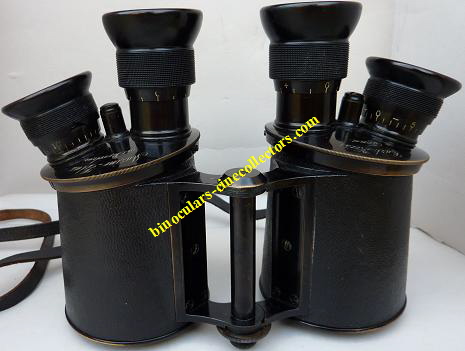
Marine glass Revolver 5&10 Carl Zeiss Jena, production No 155. Copyright picture Anna Vacani

Marine glass Revolver 5&10 Carl Zeiss Jena, production No 155. Copyright picture Anna Vacani
External features of the binocular
The binocular is made from brass and alloy, covered with brown leather. The prism housing is constructed in an unusual circular shape. This shape was necessary to incorporate the revolving mechanism of the eyepieces.
The prism housings are marked with a silver script - cursive. On the top left side is “Carl Zeiss Jena”; when the binocular is set on 5 magnifications.
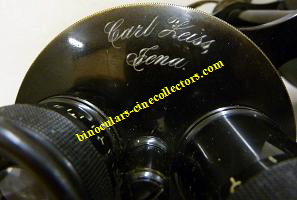
The left prism housing; Copyright picture Anna Vacani
On the top right side is “Marine-Glas m.Revolver” (Marine Glas mit Revolver) = Marine Glass with Revolver; when the binocular is set on 5 magnifications.
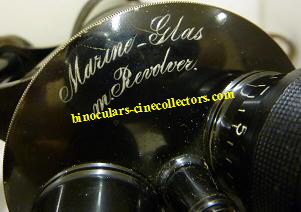
The top right prism housing; Copyright picture Anna Vacani
On the left bottom side is “verg. = 5&10” – the magnification of the binocular. Later on it was marked on Carl Zeiss binoculars – Fach for the magnification.
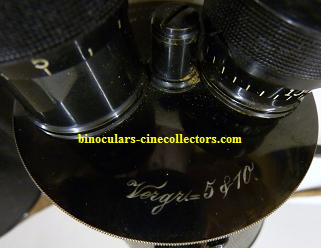
The left bottom prism housing (“Marine-Glas m.Revolver” opposite); Copyright picture Anna Vacani
On the bottom right side is “D.R.P.” ( Deutsches Reichs-Patent) - Patent of the German Reich.[2]
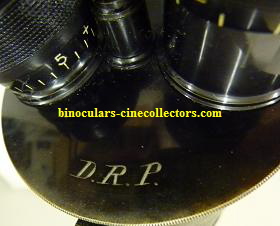
The bottom right prism housing (Carl Zeiss Jena opposite); Copyright picture Anna Vacani
This kind of script was applied on Carl Zeiss Jena binocular up to 1904. Next was a new logo when – “Carl Zeiss Jena” words were written into a lens shaped logo. [3]

The plates around the objectives have little mysterious symbols; numbers, arrows and a letter. The numbers were established by the British Army.

Marine Glass Revolver 5&10 Carl Zeiss Jena, the bottom plates. Copyright picture Anna Vacani
Dr Stephen Rohan explains the numbers in his latest book. “In September 1914, the British army devised designations for privately donated binoculars. Binoculars were classified as to their type and quality. Each donated binocular (or bought abroad) [4] was marked with a capital letter S followed by the grade classification. As an example, the S6 designation would have been applied to a donated Zeiss marine revolver binocular, indicating a binocular of unusual design.” [5]
The categories from Dr Stephen Rohan book:

Other abbreviations found on British binoculars

William Reid gives an advance explanation of the marks engraved on the binoculars:
“A year into the first world war an intensive effort was made to supplement contract purchases of official binocular patterns with commercial models from home and overseas sources, the so-called ‘trade patterns’. This highly successful exercise, [….] was in due time empowered by an Order in Council commandeering such suitable instruments as were still in private ownership or on the shelves of retailers. The order was brought to the nation’s attention in the usual way, through an announcement in The London Gazette [23 November 1915, p.11591 – footnote W. Reid]

As the authorities had to be sure that these commercial instruments were suitable for military use before they were accepted and issued, they all needed to be examined by knowledgeable optical artisans. “ […..] Next it was considered “How best to indicate clearly on each instrument its class and condition. [..] solution was based on the shape [..]the broad arrow [..] that has been used to mark Crown or government property since the fourteenth century.” [6]
The arrow’s shape which is engraved on our binocular indicates that the binocular passed the final test issued by National Physical Laboratory and was accepted and received the complete broad arrow. The instruments which had not passed complete test received not complete arrows shape – without one part.
During all the period of purchasing the binoculars, it was bought on a contract by British Government, over five thousand binoculars from the USA. The binoculars were tested at Woolwich Royal Arsenal, London.[7] Unfortunately they did not pass the test and achieved only mark S2. Today we can see them for sale on eBay very often.
On the right side of our binocular is engraved – No 6; the British Military number and arrow. This number signifies a dual power binocular or periscope. The arrow indicates that our binocular passed all tests provided in laboratory and accepted for using in the British Army.
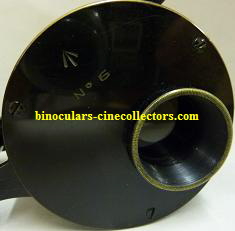
The right bottom prism cover plate; Copyright picture Anna Vacani
On the left side bottom prism plate is engraved the mark - S. 6; the British Military number and arrow, in the same shapes, as they are engraved on the right side.

The left bottom prism cover plate; Copyright picture Anna Vacani
We can find the explanation of these marks and number in the article written by William Read - ‘Binoculars in the British Army’ as well.
We learned this binocular was used during the W.W.I in British Army service. Presumably the binocular was loaned to the British Army by a privet person.
On the binocular frame is production number - 155.

Production number engraved on the frame; Copyright picture Anna Vacani
Our Marine Revolver has additional description. It appeared that our binocular was sold in a Manchester shop. The shop owner engraved their name and address on the metal neck strap attachment bars.


The name and address of the shop which sold the binocular; Copyright picture Anna Vacani
In the view of the William Reid explanation, our binocular could be purchased by the British Army from that shop.
The binocular is not so high – it is only 82 mm, and 184 mm width. Because of that double optics in the body the binocular is rather heavy – 1180 grams (2.6 pounds).
Internal features of the binocular
The binocular is prismatic – optical construction Porro I, with dual-power: 5 & 10 magnification. A rotating eyepiece turret allows either 5 or 10 power oculars to be used.

Eyepieces 5& 10 magnification; Copyright picture Anna Vacani
The shorter eyepiece is for 10 magnification, when longer is only 5 magnification. The description on the top plate – m.Revolver indicates the kind of movement by changing the lenses. When the lens is moved to a proper position, we can hear the characteristic click like in a revolver.
The field of view at 5 magnifications is 120 meter at 1000 meters, and 6.85 degrees. At 10 magnifications the field of view is only 70 meters and 4 degrees.
Our binocular does not have a reticule fitted.
Dr Stephen Rohan says about the military model Marine Revolver: “Some specimens that were made for the military are found with a reticule in the right ocular assembly”. [8]
As we heard the military Marine Revolver binoculars were bought privately by commissioned officers, in the army and navy. The binoculars had not been bought by the army on the contract to Carl Zeiss Jena.
---------------------------------------------------------------------
[1]. Hans T. Seeger - Militärische Ferngläser und Fernrohre in Heer, Luftwaffe und Marine; Military Binoculars and Telescope for Land, Air and Sea Service; Germany Hamburg 1995; ISBN 3-00-000457-2.
[2]Hans Seeger – as above
[3]Hans T. Seeger - Felstecher. Ferngläser im Wandel der Zeit; Germany Hamburg 1989. Binoculars through the ages. The translation of the title into English, by Google language tools.
[4]The information added by the authors of this article
[5]Dr. Stephen Rohan – A Guide to Handheld Military Binoculars 1894-1945. Published by Optical Press Bradbury, California, 2001(ISBN 0-9709003-0-9) - Chapter 7 ‘British binoculars’
[6]William Reid – Barr & Stroud Binoculars and The Royal Navy. Published by National Museums of Scotland, Edinburgh 2001 (ISBN 1-901663-66-3) – Chapter 10
[7]http://en.wikipedia.org/wiki/Royal_Arsenal
[8]Dr. Stephen Rohan – A Guide to Handheld Military Binoculars 1894-1945. Published by Optical Press Bradbury, California, 2001(ISBN 0-9709003-0-9) - Chapter 7 ‘British binoculars’
|